|
|
|
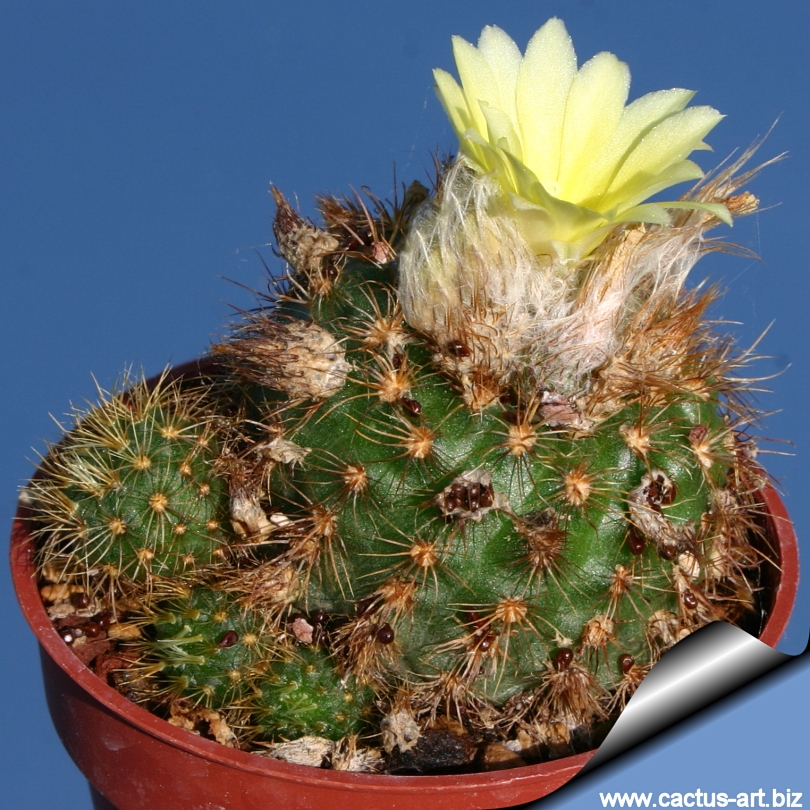
Frailea pygmaea v. dadakii
|
|
Description:
Frailea pygmaea as the name implies ("pygmaeus"
meaning dwarf), is a very small cactus that lives half buried in the
ground. Most of the plants in habitat are
single headed unless they are damaged.
Root: Long tuberose, inversely conical 2-3 cm wide.
Stem: Typical F. pygmaea has a flattened, light
green to dull green body, depressed at the crown, ,
with a turbinate base, 1
to 3 cm in diameter. Some forms
have distinctive dark crescent-shaped marks below the areoles.
Ribs: 13-21 ribs, quite flat divided by transverse depression
into tiny tubercles
(more noticeable when the
body is dehydrated).
Areoles: At first with witish or slight yellow wool.
Spines: 6 -10 quite fine,
short, bristly,
setaceous, glassy, white radial
spines, 1-
4 mm long, adpressed
and rarely also one or
two small central spines. They are straight or slightly curved. Some
forms have longer white spines that are basally orange yellow in colour
while other have yellow spines and wool.
Flowers: Arising from the crown from a very woolly bud, often
cleistogamous, 2 to 2.5 cm, up to 3 cm diameter, pale yellow, with
dense, whitish to rose-colored pubescence outside. Inner perianth-segments
lanceolate, acute, yellow; filaments and style white; stigma-lobes
yellowish. But don't be disappointed when the
easily produced
buds fail to open. Fraileas are
cleistogamous meaning that their flowers produce seed without even
opening. Without the need for
pollination, hence the buds rarely reach full
bloom and remain closed. They will open only in great heat in the
hottest, brightest, afternoon sun, if at all.
Blooming season:
Hottest part of
summer.
Fruit:
Dry
indehiscent that detach easily,
pear-shaped, 1,5 cm tall, 1 cm in diameter, with short matted hairs and
with a pointed head of bristles. The fruit wall is thick,
membranous, fragile and it
opens by a basal pore to release the seeds that are promptly harvested
by ants.
Seeds: Elm shaped, 2 mm. long, shining, black with large oblong
hilum nearly as long as the body.
The "dadakii" form is
globular, depressed on top, with about 12 ribs. It branches profusely
from the base forming soon dense clumps. The spines are all radial,
usually 8, brownish passing to white, curved backwards and twisted.
|
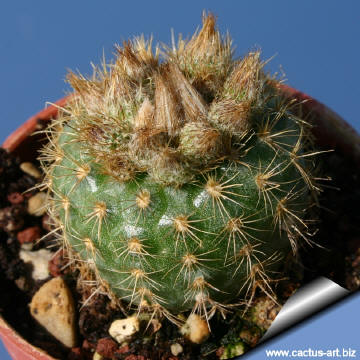 |
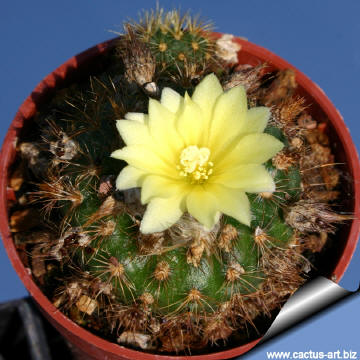 |
| |
|
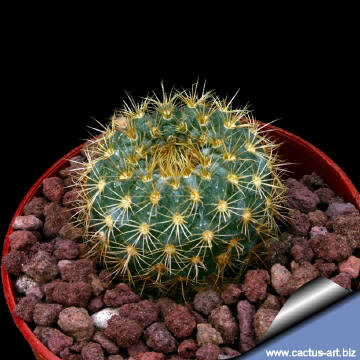 |
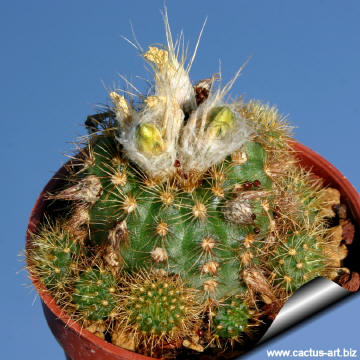 |
|
Cultivation: Grow them in
rich, porous soil and let them dry out between waterings. These plants
need a minimum temperature of 5-10° C (but occasionally temperatures of
a few degrees below 0° are not dangerous)
Sun Exposure: They
enjoy full sun but in a shaded position the plants grow faster, but are
not flat
shaped.
Characteristically, during the
dry season plants
retract completely
under the ground both in the
wild and in
cultivation too.
Notes: This plant is short living (It does not live long - about
10-15 years).
Propagation:
With fresh harvested seeds.
|
|
Photo of conspecific taxa, varieties, forms and cultivars of plants
belonging to the
Frailea pygmaea
complex
(This
Taxon
has lots of synonyms whit several controversial varieties and subspecies
and comprises a multitude of different forms):


|
|
Advertising
|
|
|
|
|
Family:
Cactaceae (Cactus
Family) Frailea
pygmaea var. dadakii (Frič) Backeberg
In: Die Cactaceae, 3: 1659, 1959
Accepted
Scientific Name:
Frailea pygmaea
An. Mus. Nac. Buenos Aires III.4:497, 1905
Echinocactus dadakii
Frič
In: Praktický rádce pro zahradnictví a chov drobného
zvířectva, 17: 65, 1922
Frailea dadakii (Frič) Berger
In: Kakteen, p. 218, 1929
Distribution: Widespread
over a wide area in Brazil, Uruguay and Argentina.
Habitat &
ecology:
Grows often in mountainous region
in scattered but numerous populations, and it is often quite common.
Usually it is found in the crevices of rocky outcrops, between the
pebbles near these outcrops or in grassy, gravelly areas where the thin
soil depth minimizes any competition from other plants. It is often
found growing together with F. gracillima and
F. castanea. The rain fall are quite frequent and often
abundant.
Conservation status: Listed in
CITES Appendix II
Etymology:
The
genus name
"Frailea"
remembers
the Spanish "Manuel
Fraile",
born in 1850 who was responsible for the
cactus
collection of the
Department of Agriculture of the United States at the end of the XIX
century.
The
species name name
"pygmaea"
derives from the Latin name “pygmaeus” which means
“dwarf” and refers to the very deminute dimension of this plant.
( The specific name implies:
"very dwarf").
|
|
|
|
NOTE:
F.
pygmaea has a wide distribution and is very variable with some forms
having heads no wider than one or two centimetres.
In accordance with the variability of the species, many names have been
created for different forms, some of them correctly published but the
majority invalidly and nowadays considered as
synonyms:
- Frailea pygmaea ssp.
albicolumnaris (F. Ritter) A. Hofacker,
Cactaceae Consensus Initiatives 6: 11, 1998
This is the most distinctive variation, and the only one
accepted at infraspecific rank that grows in Rio Grande do Sul, it is
a stouter form up to 4 cm in diameter and 8 cm in height,
distinguished by the glaucous greyish-green epidermis and the tendency
to become columnar, also it has many straight and vertical ribs not
broken into tubercles.
- Frailea pygmaea ssp.
altigibbera (F. Ritter) P.J. Braun & E. Esteves Pereira
Succulenta (Netherlands) 74 (3): 131, 1995
- Frailea pygmaea ssp.
asperispina (F. Ritter) P.J. Braun & E. Esteves Pereira
Succulenta (Netherlands) 74 (3): 131, 1995
- Frailea pygmaea ssp.
aureinitens (A.F.H. Buining & A.J. Brederoo) P.J. Braun & E.
Esteves Pereira
Succulenta (Netherlands) 74 (3): 131, 1995
- Frailea pygmaea ssp.
aureispina (F. Ritter) P.J. Braun & E. Esteves Pereira
Succulenta (Netherlands) 74 (3): 131, 1995
- Frailea pygmaea ssp.
fulviseta (A.F.H. Buining & A.J. Brederoo) P.J. Braun & E.
Esteves Pereira
Succulenta (Netherlands) 74 (3): 131, 1995
- Frailea pygmaea ssp.
hyssooniana K.H. Prestlé
Gattung Frailea (Br. & R.) Prestlé: 83, without
latin descr. or type, 1997
- Frailea pygmaea ssp.
lilalunula (F. Ritter) P.J. Braun & E. Esteves Pereira
Succulenta, 74 (3): 131: 1995
- Frailea pygmaea ssp. pygmaea
- Frailea pygmaea ssp.
tuyensis Metzing
Cact. Syst. Init. No 21: 16
- Frailea pygmaea var.
aceguaensis K.H. Prestlé
Gattung Frailea (Br. & R.) Prestlé: 103, without
latin descr. or type, 1997
- Frailea pygmaea var.
albispina
- Frailea pygmaea var.
altigibbera Ritter
Kakteen in Südamerika, Vol.1, 203, Spangenberg 1979
- Frailea pygmaea var.
applanata K.H. Prestlé
Gattung Frailea (Br. & R.) Prestlé: 81, without
latin descr. or type, 1997
- Frailea pygmaea var. argenta
K.H. Prestlé
Gattung Frailea (Br. & R.) Prestlé: 87, without
latin descr. or type, 1997
- Frailea pygmaea var.
atrofusca Backeberg
Kaktus-ABC 250. 1935 Without Latin diagnosis; Cactac.
3:, 1935
- Frailea pygmaea var. aurea
(Backeberg) Backeberg
Cactaceae (Backeberg) 3:, 1959
- Frailea pygmaea var.
auricantha K.H. Prestlé
Gattung Frailea (Br. & R.) Prestlé: 81, without latin
descr. or type, 1997
- Frailea pygmaea var. bagensis
K.H. Prestlé
Gattung Frailea (Br. & R.) Prestlé: 102, without
latin descr. or type, 1997
- Frailea pygmaea var.
brunneo mollispina
(Zaadlijst 2006 CaVe)
- Frailea pygmaea var.
carpinteria K.H. Prestlé
Gattung Frailea (Br. & R.) Prestlé: 78, without
latin descr. or type, 1997
- Frailea pygmaea var.
castaneoidea K.H. Prestlé
Gattung Frailea (Br. & R.) Prestlé: 79, without
latin descr. or type., 1997
- Frailea pygmaea var.
catiensis
- Frailea pygmeae var.
corallima
(Zaadlijst 2006 CaVe)
- Frailea pygmaea var.
corallina K.H. Prestlé
Gattung Frailea (Br. & R.) Prestlé: 82, without
latin descr. or type, 1997
- Frailea pygmaea var.
curvispina F. Ritter
Kakteen in Südamerika, 1: 204, 1979
- Frailea pygmaea var. dadakii
(Fric ex Berger) Backeberg
Cactaceae (Backeberg) 3:, 1959
- Frailea pygmaea var.
elegantissima
- Frailea pygmaea var.
gemmrichii K.H. Prestlé
Gattung Frailea (Br. & R.) Prestlé: 98, without
latin descr. or type, 1997
- Frailea pygmaea var. gloriosa
K.H. Prestlé
- Gattung Frailea
(Br. & R.) Prestlé: 79, without latin descr. or type., 1997
- Frailea pygmaea var.
grandiflora
- Frailea pygmaea var. insignia
K.H. Prestlé
Gattung Frailea (Br. & R.) Prestlé: 91, without
latin descr. or type, 1997
- Frailea pygmaea var.
krausiana K.H. Prestlé
Gattung Frailea (Br. & R.) Prestlé: 80, without
latin descr. or type, 1997
- Frailea pygmaea var.
largoensis K.H. Prestlé
Gattung Frailea (Br. & R.) Prestlé: 77, without
latin descr. or type, 1997
- Frailea pygmaea var.
lilalunula
- Frailea pygmaea var.
longispina F. Ritter
Kakteen in Südamerika, 1: 204, 1979
- Frailea pygmaea var. maior
F. Ritter
Kakteen in Südamerika, 1: 204, 1979
- Frailea pygmaea var.
major
(Zaadlijst 2006 CaVe)
- Frailea pygmaea var.
minanensis
- Frailea pygmaea var.
mollispina-brunnea K.H. Prestlé
Gattung Frailea (Br. & R.) Prestlé: 99, without
latin descr. or type, 1997
- Frailea pygmaea var. montana
K.H. Prestlé
Gattung Frailea (Br. & R.) Prestlé: 81, without
latin descr. or type, 1997
- Frailea pygmaea var.
olimarensis K.H. Prestlé
Gattung Frailea (Br. & R.) Prestlé: 82, without
latin descr. or type, 1997
- Frailea pygmaea var.
phaeodisca (Spegazzini) Y. Ito
Cacti (Borg), 70. 1952, 1952
- Frailea pygmaea var.
planicosta F. Ritter
Kakteen in Südamerika, 1: 204, 1979
- Frailea pygmaea var.
pulcherrima (Arechavaleta) K.H. Prestlé
Gattung Frailea (Br. & R.) Prestlé: 84: 1997
- Frailea pygmaea var.
sakusiana
- Frailea pygmaea var.
salascana
- Frailea pygmaea var.
salusiana
- Frailea pygmaea var.
santanaensis K.H. Prestlé
Gattung Frailea (Br. & R.) Prestlé: 87, without
latin descr. or type, 1997
- Frailea pygmaea var.
viridilunula K.H. Prestlé
Gattung Frailea (Br. & R.) Prestlé: 97, without
latin descr. or type, 1997
|
|